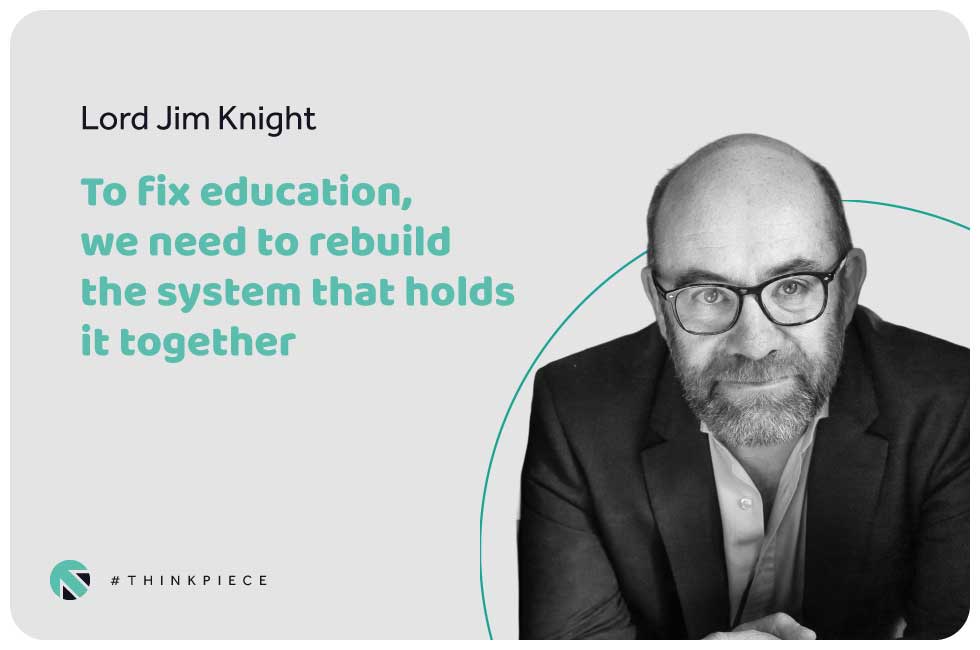Education must not be left behind as the government looks to rebuild national infrastructure. Lord Jim Knight argues that the FED Futures report and National Education Assembly offer the collaborative roadmap our system needs.
To fix education, we need to rebuild the system that holds it together
It’s been almost twenty years since I was schools minister and there has certainly been buckets of “education reform”, and yet little has changed in outcomes. Structures have been pulled apart, accountability tightened, more proscribed from the centre but what have we built?
Reform has not delivered because we have ignored what holds the system together: the relationships.
That’s why I welcome the launch of the FED Futures 2025 report from the Foundation for Education Development (FED), particularly its call to rebuild the connective tissue of our education system. At its heart is an explicit declaration: partnership isn’t optional. It’s essential. No single school, college, MAT, or local authority can deliver on the scale of ambition we now need. Yet time and again, they’re expected to do it alone.
A recent national survey commissioned by the FED makes this all too clear. Just 18% of stakeholders say that schools and colleges work well together to support all learners. And 48% say they lack confidence that area-based collaboration will improve in the year ahead.
These aren’t abstract issues. They are everyday realities in a system that often rewards individual performance but not collective action.
Over the past decade, local authority infrastructure has been hollowed out. Academy trusts like E-Act, where I am Chair, are doing excellent, sometimes brilliant, collaborative work. But we’re left with a patchwork of isolated effort without bridges to connect that energy across the broader ecosystem. When those bridges are missing, opportunities are lost, gaps widen and vulnerable children fall through the cracks.
That’s why the Partnerships focus of FED Futures 2025 is so important. It calls for rebuilding what is often called the “middle tier” — the local layer of coordination that once helped schools, colleges, councils, and services work together.
This isn’t about bringing back top-down bureaucracy, but creating a more innovative, more flexible framework that enables shared strategy, clear accountability and joined-up working across local areas.
Among its recommendations are:
- Clear expectations for collaboration between MATs, local authorities, colleges, employers, and civic partners
- Investment in data-sharing tools, shared leadership development, and local governance mechanisms
- Funding models that support long-term place-based planning, rather than short-term institutional competition
This is where the National Education Assembly (NEA) comes in. It’s not just another event or policy consultation. It is a serious attempt to rebuild the civic infrastructure our education system has lost. Created by FED and launching later this year, the NEA will be a fully independent, stakeholder-led forum that brings together everyone with a stake in education: schools, colleges, MATs, learners, parents, employers, local authorities, unions, researchers and policymakers.
But it’s not about talking more. It’s about action. The aim is to co-create solutions, surface what works locally, and connect it with what’s happening nationally. Crucially, it’s designed to support place-based partnerships — helping them share learning, align strategy and scale what’s effective. If we’re serious about long-term change, we need something like the NEA to make joined up working the norm, not the exception. It’s a way to rebuild shared purpose and rebuild trust while we’re at it.
We’ve seen the power of place-based collaboration: schools working with local employers to align curricula to regional needs; trusts and councils combining efforts to coordinate inclusion and wraparound services; communities developing shared approaches to post-16 pathways. But these successes remain too often the exception, not the norm. Turning these exceptions into the norm means harnessing the intelligence that already exists within the system, and that happens through deep, trust-based relationships that enable schools and partners to learn from each other, not just from the top down. The NEA is a vehicle for precisely this: enabling the kind of sustained, trust-based collaboration that is the foundation of a self-improving system.
If we want them to spread, we have to change the rules of the game.
That means:
- Redesigning accountability to reward contribution to shared local goals
- Funding local “brokers” to coordinate partnerships across education, employment, and care
- Rebuilding civic capacity to support coordination — not control — of delivery
- And giving local areas the autonomy to shape how these partnerships function for their unique context
Over the past five years, FED has built an extraordinary space for long-term thinking in education. Its work has brought together thousands of voices—and they’re not asking for revolution. They’re asking for coherence, continuity and systems that make it easier to work together, not harder.
Because what we’ve learned — painfully — is that autonomy without alignment leads to fragmentation. And fragmentation makes it harder for anyone to succeed, especially those with the least margin for error.
With a new government in place and a 10-year Industrial Strategy on the table, we have a golden opportunity to align educational ambition with economic and social renewal. But it won’t happen unless we rebuild the architecture that lets systems work together.
If we want a lasting impact, we need to support the partnerships already making a difference and give them the support to grow. Strong education systems aren’t built on structures alone. They are built on relationships. And now is the time to invest in them.



